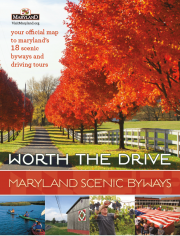Scenic Byways Religious Freedom
Peaceful country roads take you on a journey to Maryland’s colonial past, where historic churches honor the struggle for religious liberty. Admire red-brick colonial dwellings, marvel at rolling farmland and take in stunning views of the mighty Potomac.

The drive is part of the Great Chesapeake Bay Loop
189 Miles
Drive Time: 5-7 Hours
Best Done in 3-5 Days
Best for: history lovers, nature lovers
Open for Exploration
Religious Freedom
Travel along tree-lined backroads and through the rolling farmland of Southern Maryland—the cradle of American religious liberty—where historic churches stand as powerful reminders of the nation's earliest quest for freedom of worship. Along the way, take in the charm of red-brick colonial homes and historic estates, punctuated by the backdrop of the Potomac River.
Travel along tree-lined backroads and through the rolling farmland of Southern Maryland—the cradle of American religious liberty—where historic churches stand as powerful reminders of the nation's earliest quest for freedom of worship. Along the way, take in the charm of red-brick colonial homes and historic estates, punctuated by the backdrop of the Potomac River.
To board a tiny ship and set sail across the broad unknown of the Atlantic, Maryland’s first English colonists must surely have been drawn by something magnificent, and indeed, they were. Maryland was a new world where new ideals might take hold. They gave up not just their old lives, but their whole known world to build a new home on Maryland’s shore.
In Historic St. Mary’s City, hailed as “the birthplace of religious toleration in North America,” settlers helped shape the foundation of American religious freedom—a vision in sharp contrast to the eventual employment of enslaved, unfree labor in the region. Today, you can follow in the wake of these pioneers through a tidewater land in places unspoiled by the winds of time along the Religious Freedom Byway. This route is also part of the Great Chesapeake Bay Loop and visits places to enjoy and explore the bay.
Port Tobacco Loop
Including MD 6, MD 425 & MD 224
The byway begins in Port Tobacco, once a Potapoco Indian village where Jesuit Father Andrew White established a missionary outpost in the seventeenth century. One of the busier ports in Maryland, Port Tobacco traded with markets around the world. In addition to global goods, enslaved Africans were imported here for purchase and held in bondage in the surrounding community.
In Port Tobacco, visit historic Stagg Hall, which is open for weekend tours.The 18th century home is part of the Underground Railroad in Southern Maryland. Then, explore the Port Tobacco Courthouse and Jail, a National Underground Railroad Network to Freedom site, now a museum featuring tobacco exhibits and archaeological finds.
Continue west, stopping at the Christ Church Durham Parish. Though the parish dates to 1692, the current handsome red-brick structure was constructed in the 1730s. Back on the Byway, travel leafy country roads that evoke the quiet of Maryland’s earliest days. Stop to stretch your legs with an easy hike or hunt for fossils at the Chiles Homestead Area of Douglas Point Special Recreation Management Area, which is part of the Potomac Heritage National Scenic Trail.
A short drive away is Mallows Bay where you can canoe or kayak (paddle boarding is not recommended) out to see a "Ghost Fleet," a diverse collection of shipwrecks of more than 200 known sunken vessels that have evolved into incredible habitats for birds, fish and other wildlife. A brochure with a self-guided tour of the fleet is available at the site and Atlantic Kayak offers guided paddle tours. Mallows Bay also has a nature loop hiking trail for those who prefer to stay on land.
Next, is Smallwood State Park, which houses the restored home of Gen. William Smallwood, a Revolutionary War hero and the fourth governor of Maryland. “Smallwood’s Retreat” is open seasonally (and by request on weekends) for tours. A slaveholder and large landowner, Smallwood was one of the wealthiest men in Charles County–even six years after his death.
Smallwood State Park has camp sites, cabins, a marina with boat launching ramps, a picnic area, pavilions, playgrounds, nature trails and excellent fishing opportunities.
Freshwater fishing is available on a 23-acre lake inside the Myrtle Grove Wildlife Management Area. Then, as you head back to Port Tobacco, be sure to stop by the Mt. Carmel Monastery, which was established in 1790 as America’s first religious community for women.
The last stop on this portion of the byway is the 322-acre Thomas Stone National Historic Site, which is also part of an 830-mile Potomac Heritage National Scenic Trail that stretches between the Chesapeake Bay and the Allegheny Highlands. Take a guided plantation tour to learn about Stone, who was one of four signers of the Declaration of Independence to hail from Maryland.
(continued below)
Port Tobacco to St. Clement's Island and Leonardtown
Including MD 234 & MD 238
Head south toward Chapel Point, stopping to take in views of the Port Tobacco River or to enjoy a quick dip on one of Chapel Point State Park’s small beaches. The parkland is the site of a former Piscataway Indian settlement.
Further south, visit the oldest continuously serving Catholic parish in the nation, St. Ignatius Catholic Church, which was established by the Jesuits in 1641. The church has a stained glass window depicting a Piscataway "King" being baptized by Father Andrew White. Piscataway families are members of the parish today. The parish grounds also include a statue of St. Kateri Tekakwitha, a Native American saint.
Nearby is St. Thomas Manor, which was constructed a century later and is the oldest Jesuit residence in the world still in use. Touring the grounds of this majestic red-brick church and historic two-story Georgian manor allow time for reflection on the long history of the Jesuits at the site, including the now well-known story of the order selling off their enslaved people to pay off debt incurred expanding and operating what is now Georgetown University.
Travel east to reach Chaptico, a port town that was occupied by the British during both the American Revolution and the War of 1812. Christ Episcopal Church, King and Queen Parish, was built here in 1736 on land donated by Francis Scott Key’s grandfather. The church is open to the public for tours, and visitors are encouraged to enjoy the annual strawberry and fall festivals.
Branching off the main byway, head south to Coltons Point and the St. Clement’s Island Museum, which features exhibits on Maryland’s early history and serves as a launching point for water taxi rides to the island itself. St. Clement’s Island is where Father White celebrated the first Roman Catholic Mass in the colonies. Today, the island is a state park on which a 40-foot-tall cross honors those first colonists who, in 1634, conceptualized the separation of church and state.
Make a sidetrack to visit St. Francis Xavier Church, the oldest Roman Catholic Church in the state. The charming 18th century red-brick and yellow clapboard building with box pews is well worth a visit. Beyond St. Francis Xavier is Newtowne Neck State Park, a bucolic 776-acre peninsula surrounded by Breton Bay, St. Clements Bay and the Potomac River with recreational waterfront access, including swimming beaches and a kayak launch.
Back on the Byway you’ll soon enter the heart of Leonardtown. Be sure to visit the Old Jail Museum and Leonardtown Visitor Center, making time to locate the “stopping stones” embedded in the building's yard near the entrance. These small plaques honor five enslaved people who were arrested and held at the site after attempting to seek their freedom. Nearby, Tudor Hall, a 250-year-old Colonial House, is operated by the St. Mary’s County Historical Society.
Take a stroll around the Leonardtown Wharf Park for gentle breezes and breathtaking views of Breton Bay. The Wharf hosts a summer concert series and other events. In season, you can rent stand-up paddle boards or kayaks, take a seaplane ride, get out on the water with Fish the Bay Charters or just watch the sailboats and enjoy an ice cream cone from the Frog Town Ice Cream shop.
Stay Safe & Skip the Pests!
While enjoying the natural beauty of Southern Maryland be sure to wear insect repellent. Check yourself for ticks after outside activities to help prevent bites and reduce the risk of insect-borne illnesses.
Leonardtown to Piney Point and Point Lookout
Including MD 234, MD 243, MD 5 & MD 249
The next stop is St. George’s Episcopal Church, which has held services since 1638, making it the oldest Episcopal parish in Maryland. Continue south to visit Piney Point Lighthouse Museum and Historic Park. Built in 1836, it’s the oldest lighthouse on the Potomac River. The site has water access for kayakers, a pier, and a park.
From there, make your way to St. Mary's College of Maryland, a female seminary that was established in 1840, which now is a co-educational state college and hosts a weekly summer concert series. Visit the powerful Commemorative to Enslaved Peoples of Southern Maryland while you are on the campus.
Probably the most visited destination on this byway is Historic St. Mary’s City, an expansive living-history museum and archaeology site. Serving as Maryland’s first capital from 1634 to 1695, St. Mary’s City was the fourth permanent settlement in America and site of the first Catholic chapel in the colonies. Exhibits include a reconstructed 17th-century State House, a tobacco plantation, an Indian hamlet, the Struggle for Freedom Exhibit, and a replica of the Maryland Dove, one of the two square-rigged ships that brought the first settlers to Maryland
Heading toward the Chesapeake Bay, you can see several lighthouses and visit Point Lookout State Park, which offers beaches on the Chesapeake Bay, a boat launch, fishing areas and campgrounds. But there’s another side to this picturesque peninsula — during the Civil War, Point Lookout served as a notorious prison camp where more than 4,000 Confederate soldiers died. Ghost stories abound, bringing a haunting conclusion to this spiritual journey.
Trip Tips
Visit True Chesapeake Oyster Co. to discover how oysters are sustainably—and restoratively—farmed in the pristine waters of St. Jerome’s Creek. Dive into the science behind their eco-friendly practices, or simply savor a few fresh-from-the-Bay bites for yourself.
Venture off the beaten path to St.George Island for a peaceful escape. Stay at the Island Inn & Suites, where you’ll enjoy serene water views from both sides of the property. Take time to meander around this mostly private island, perfect for quiet reflection, bird watching and tranquil scenery.
Enjoy Every Season
Spring/Summer
Spring/Summer
- Kayak Mallows Bay with Atlantic Kayak Co. and look for nesting waterfowl among the sunken ships
- Celebrate Maryland Day at Historic St. Mary’s City and St. Clement’s Island
- Immerse yourself in the magic of Renfest Southern Maryland in Leonardtown
- Spring into the season at Historic St. Mary’s City Spring Opening Celebration
- Sail back to the founding of Maryland in 1634 on a replica of the Dove
- Swim, camp and canoe at Point Lookout State Park
- Getaway for the weekend at the Potomac Jazz Festival in July (Leonardtown)
- Celebrate the Fourth at the Wharf (Leonardtown)
- Relax on a Sunset cruise from Leonardtown Wharf with Fish the Bay Charters
- Set sail for a Charter Fishing trip or a Watermen’s Heritage Tour with Fish the Bay Charters
- Tune in at the Summer Music Festival in Leonardtown (April through October)
- Photo: Historic St. Mary's City
Fall/Winter
Fall/Winter
- Check off and visit the lighthouses on the Potomac - Blackistone Light, Piney Point Lighthouse (museum), Point Lookout
- Enjoy the fall color and warm breezes on a cruise to St. Clement’s Island on the Potomac River
- Feast on delicious local oysters at the U.S. National Oyster Festival in St. Mary’s County Fairgrounds in Leonardtown
- See a Union Civil War soldier living historian at Point Lookout, a former Civil War hospital and prison
- Search for the paranormal at Point Lookout, considered a haunted site where 4,000 Civil War soldiers died
- Enjoy ghost tours, scavenger hunts, cocktail contests, and more during February’s Moll Dyer Weekend in Leonardtown
- Escape winter’s chill and explore real aircraft, flight simulators, and hands-on displays at Patuxent River Naval Air Museum in Lexington Park.
- Nibble on Christmas treats while you shop for local handmade holiday gifts at the Kris Kringle Holiday Market in La Plata.
- Photo: Point Lookout Lighthouse
STAY, DINE & PLAY ALONG THE BYWAY
Maryland Scenic Byways Guide
Maryland Scenic Byways Guide
Discover Maryland's Scenic and Historic Byways
Maryland Scenic Byways Map
Maryland Scenic Byways Map
Follow carefully mapped driving routes for all 18 scenic byways.









































